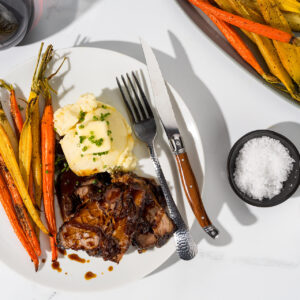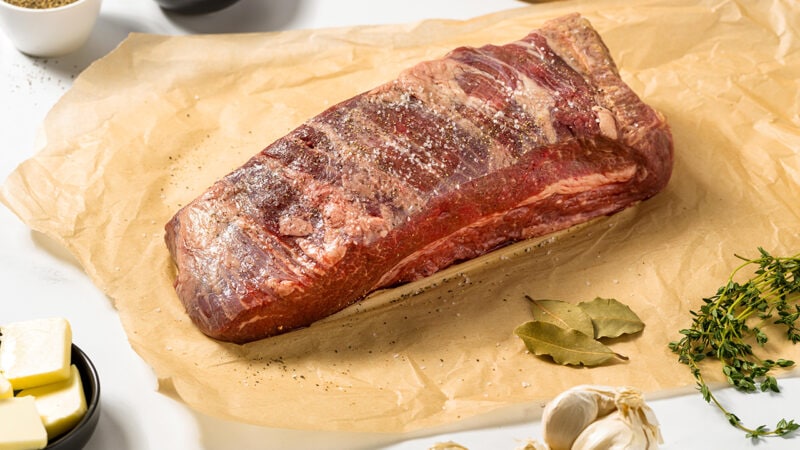Last Updated on January 27, 2025
If you love a low, slow cooking method, where you’re not dealing with a meat thermometer and your kitchen is filled with amazing cooking smells for hours, this cut is for you.
Brisket comes from the lower chest of the cow; it’s a tougher cut with a lot of connective tissue, because this part of the animal is used a lot while it moves. Cooked well, it’s very tender and juicy, with plenty of savory flavor.
Here are 3 key tips for juicy, fork-tender brisket, and an easy recipe that’s sure to become a favorite.
- Because brisket is a tough cut, it benefits from low, slow cooking methods, such as braising and smoking on the grill. It’s great for entertaining because you do most of the work ahead of time.
- When braising, for the best texture, remove the brisket from the braising liquid 30 to 60 minutes before it’s done, slice it thinly against the grain, then return it to the liquid and continue cooking. This will give you the most tender, moist brisket.
- Though grass-fed brisket has a layer of fat on the outside (known as the “fat cap”), in general it’s leaner than conventionally raised, so it will take longer for the connective tissue inside to soften and break down. If you’re using a recipe designed for conventional beef, add at least 30 minutes to the cooking time (or use one of our recipes, designed especially for our grass-fed meat).

Ingredients
- 1 ButcherBox Beef Brisket (about 2.2 pounds) thoroughly pat dry
- 3 tbsp unsalted butter
- 3 medium onions thinly sliced
- fine sea salt
- 4 cloves garlic thinly sliced
- 2 tsp dried thyme
- freshly ground black pepper
- 2 cups low sodium beef broth
- 1 tbsp Worcestershire sauce
- 1 tbsp raw honey
- 2 small to medium dried bay leaves
Instructions
- Remove the brisket from the refrigerator and allow it to sit at room temperature for 30 to 60 minutes. Trim off any large chunks of fat on the outside. Cut parallel lines partially through the fat cap about ¼ in apart, taking care not to slice all the way through to the meat. Repeat in the opposite direction, creating a crosshatch pattern.
- Preheat the oven to 300ºF. Melt the butter in a large Dutch oven over medium heat. Add the onions, season with salt and cook, stirring occasionally, until the onions are very tender, golden and caramelized, 20 to 25 minutes. (Stir in a few tablespoons of water if the pot seems dry or the onions are cooking unevenly.) Add the garlic and thyme; cook, stirring, until fragrant, 1 to 2 minutes. Using tongs, transfer the onion mixture to a large bowl. Raise the heat to medium-high.
- Season the brisket all over generously with salt and pepper. Add the brisket to the pot fat side down. Sear until browned on both sides, 3 to 4 minutes per side. Transfer the brisket to a large plate. Reduce the heat to low.
- Stir in the broth, Worcestershire sauce and honey; add the bay leaves. Add the onions back to the pot, then the brisket (and any juices that have accumulated on the plate), fat side up. Cover and transfer to the oven. Braise the brisket until the meat is cooked through, about 2 hours. Carefully remove the brisket to a cutting board and let it rest for 5 minutes. (It may seem tough at this point; don’t worry.) Remove the bay leaves from the pot.
- Thinly slice the meat against the grain. You can slice off any excess fat at this point, if you want to. Return the meat to the pot, tucking the slices into the braising liquid. Cover and continue to braise until the brisket is very tender, 45 to 60 minutes longer.
- Taste and season with more salt and pepper, if needed. Serve the brisket with the onion mixture.
Notes
Grain-Finished Beef Brisket: In general, all braised and slow cooker recipes will need to cook this brisket for an addition 1-2 hours to achieve the desired results. The other thing you can do is cut their brisket in half before cooking it. As for smoking, follow the same general guidelines, but cook the brisket 5-6 hours longer to achieve the desired doneness.Share on Pinterest!Pin at @Butcher_Box!
Beth Lipton is a Brooklyn-based recipe developer and writer specializing in food and wellness. Her work has appeared in Clean Eating, Paleo magazine, FoodNetwork.com, Well+Good, Outside, Sleep.com and more. Beth's latest cookbook, Carnivore-ish, featuring 125 animal protein-forward recipes, is available now.



